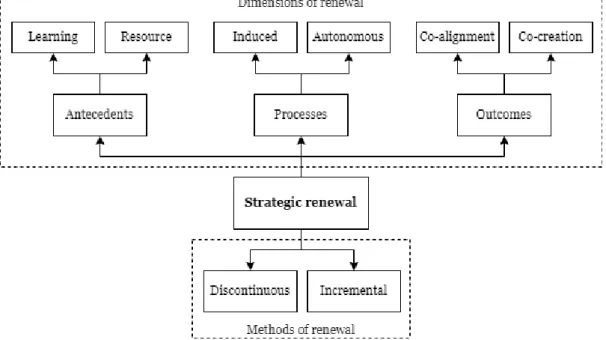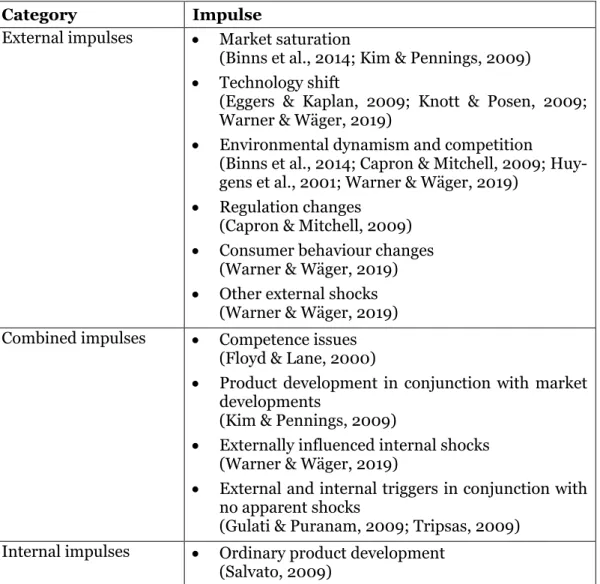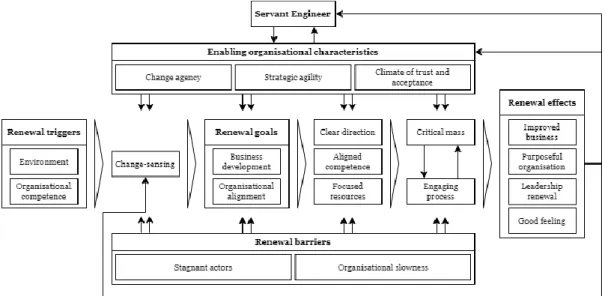In addition, this thesis presents a process model of the factors that enable successful strategic renewal. This thesis aims to discover how to successfully lead strategic innovation in the technology industry.
Research objective and questions
Structure of the thesis
Engineering leadership
Definition
A technical leader's orientations include the leader's interaction skills, capabilities, and behaviors (Li et al., 2022; Rottmann et al., 2015). Positive community impact refers to the impact beyond the leader's own organization (Li et al., 2022).
Similarities with servant leadership
In servant leadership, employees are not the means to an end, but the end itself (Eva et al., 2019; van Dierendonck, 2011). Although engineering leadership and servant leadership are remarkably similar, relatively few studies have focused on this connection.
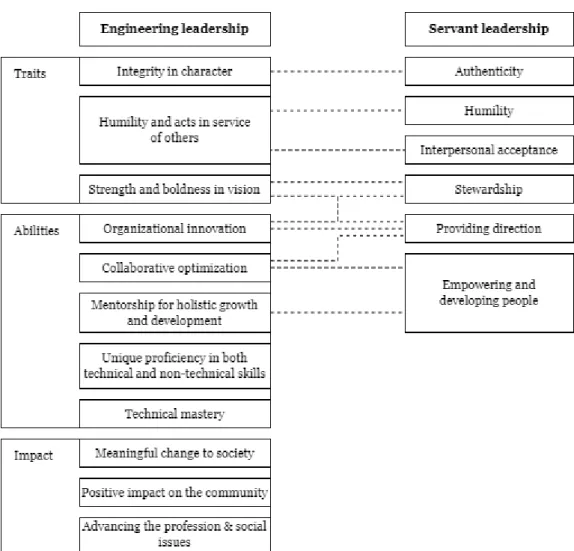
Strategic renewal
Related concepts
This distinction of strategic renewal excludes other forms of strategic change, including strategic expansions, additions, and deletions (Agarwal & Helfat, 2009). However, the literature is not uniform in the division between corporate entrepreneurship and strategic innovation.
Methods
The continuous use of incremental renewal strategies can reduce the need to carry out a much larger discontinuous transformation in the future (Agarwal & Helfat, 2009). Incremental innovation is particularly useful in keeping the competencies of an organization fit and ready for emerging changes in the environment (Agarwal & Helfat, 2009; Hamel & Välikangas, 2003).
Dimensions
The process dimension refers to who in the organization initiates and leads strategic renewal (Volberda et al., 2001). Two possible purposes of strategic renewal are extensively discussed in the literature: co-alignment and co-creation (Schmitt et al., 2018).
Strategic renewal in practice
Impulses for renewal
These types of internal impulses can be competence issues (Floyd & Lane, 2000), product development in relation to market developments (Kim . & Pennings, 2009), or internal shocks influenced by shocks in the external environment (Warner & Wäger, 2019). For example, an organization's ordinary product development has the potential to trigger strategic renewal (Salvato, 2009).
Enabling and hindering factors of renewal
Dynamic capabilities are the capabilities of the organization to continuously create, integrate and reconfigure its expertise (Teece et al., 1997). Thus, organizations attempting strategic renewal must commit adequate resources and organizational focus to the renewal effort (Binns et al., 2014).
Research design
Consistent with the principles of constructed theory, the research design of this study is extremely iterative, cyclical, and constantly connected to data, where data collection and analysis are deeply intertwined (Eisenhardt, 1989; Gioia et al., 2013; Gioia & Pitre, 1990). Semi-structured interview is used to gather retrospective knowledge from the manager-informants who have experienced the theoretically interesting phenomenon of successful strategic renewal (Gioia et al., 2013). Theory is reviewed only after the initial 1st and 2nd order concepts have been generated to avoid repeating existing knowledge or drawing premature conclusions (Gioia et al., 2013).
Finally, a new grounded theory that describes an empirically valid process emerges from the theory-driven relationships between concepts, themes, and dimensions in the data structure (Gioia et al., 2013). The chapter describing the criteria is followed by detailed descriptions of data collection and data analysis.

Theoretical and convenience criteria
The fifth and final theoretical criterion required equal representation of women and men in the data set. Since all leaders were already verified to have experience in successful renewal efforts, the random sampling approach. Although the fifth theoretical criterion proved to be the most difficult to achieve, the difficulty of the task made it all the more important.
All 13 participating leaders also fit extremely well with the theoretical criteria of the research, thus requiring no changes to the original research focus. Although theory building typically uses multiple data collection methods, time and people constraints meant that only one primary data collection method could be used (Eisenhardt, 1989).
Data collection
The following questions in this section were then targeted to gain an understanding of the factors behind the successful strategic renewal decided. Finally, the third part of the interview was used to allow the manager to summarize and summarize the enabling and hindering factors of strategic renewal. In addition, the last part of the interview also allowed the manager to freely express any remaining thoughts about strategic renewal in order to fish out the possible knowledge that the interview structure or the questions that arose might have missed.
This test interview helped to test the rough structure of the semi-structured interview and edit it prior to the actual data collection. In addition, factors which in combination would reveal the interviewee's identity were anonymised.
Data analysis
The goal here was to create the initial 1st order concepts with as much voice as possible given to the leaders' thoughts. In the cross-case analysis, the aim was to discover commonalities and relevant differences between individual codes to further refine the 1st-order concepts and generate the 2nd-order themes. With the now generated 1st order concepts, 2nd order themes and total dimensions, the basis for building a comprehensive data structure is established (Gioia et al., 2013).
The first part was to constantly sharpen the themes by comparing them with the data. The aim was to see if the findings had been discovered before and if the study had discovered new concepts.
Leadership philosophy
- Empowerment & development
- Stewardship
- Interpersonal acceptance
- Direction providing
- Humble
- Authentic
However, in the servant mindset there is also an added emphasis on personal competence, similar to the unique knowledge of technical and non-technical skills present in exemplary engineering leadership. Managers perceived that in order to support employees, the manager's task is also to create an environment that utilizes the full potential of the organization. A final link between leaders' narratives and servant leadership comes in the form of authenticity.
Instead, leadership is an ongoing process of being consistent and present in the moment to ensure that the organization and its members succeed not just on a single day, but every day. Leaders experienced in successful innovation journeys tend to base their leadership philosophy on the principles of servant leadership with some proficiency in the skills relevant to the organization's success.
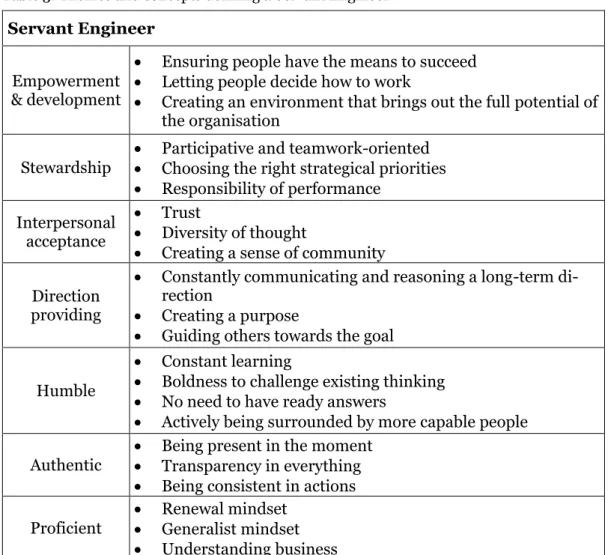
Context of successful strategic renewal
- Strategic renewal is continuous
- Triggers: environment and organisational competence
- Goals: business development and organisational alignment
- Effects: Achieved goals, leadership renewal, and a good feeling
Success in a redesign requires that the tools used match the goal of the redesign, the current environment, and the core organization. As has often been noted in the literature on strategic renewal and strategic change, the triggers for renewal are usually external. This commonality was also evident among the respondents, as events in the core environment of the organization were often cited as the main impetus for renewal.
Here, triggers for renewal emerged not only from current events in the external environment, but also from the organization's ability to predict how this environment would evolve in the future. This development goal was the creation of new business or the renewal of the existing business in the form of a renewal of the business model.
Factors of successful strategic renewal
- Change agency
- Strategic agility
- Climate of trust and acceptance
- Change-sensing
- Clear direction
- Aligned competence
- Focused resources
- Critical mass
- Engaging process
Change perception is the ability of an organization to perceive external and internal triggers for renewal and to convert these triggers into objectives for strategic renewal. In addition, certain people must be capable and committed to ensuring the success of the renovation. The people who think about the renovation at the core of the renovation, also known as change agents, have been cited as a key factor in ensuring a successful renovation.
As much as a forward-looking mindset can support renewal, fixed thinking and a culture that is not aligned with renewal are, on the contrary, major barriers to renewal success. Most of the leaders emphasized the importance of funds directed specifically to renovation.
Education preparing for strategic renewal
- Problem solving skills
- Theoretical knowledge
- Social psychology skills
- Contextual understanding
This thesis' findings on successful strategic renewals mostly correlate with the concept of incremental strategic renewal (Agarwal & Helfat, 2009). It is important that this thesis creates a grounded theory about the enablers of successful strategic renewal (see Figure 6: Strategic renewal process model). With the process model, this thesis answers the shortcomings of previous work on the enabling factors of strategic innovation (Hopkins et al., 2013).
This thesis provides new ways to understand the connection between management philosophy and success in strategic renewal. Another reason for the similarities between managers could be that the Finnish culture or a long tenure in the technology industry affects the managers.
Theoretical implications
Finally, a third reason may be that strategic renewal topics are currently not taught in detail in higher education. Future studies should further investigate why servant leadership is perceived to be an important enabler of strategic renewal. Although successful strategic renewal in this thesis was perceived in similar terms by the executives interviewed, several indicators emerged to suggest that the renewal process could be viewed differently based on the interviewee's position in the organization.
In particular, the starting point for strategic innovation can be viewed differently based on the organizational level of the interviewee. With this fourfold perspective, light could be shed on the observed similarities and especially the differences within specific cases of strategic innovation.
Practical implications
Educational implications
People in professional life would greatly benefit from the frameworks and latest knowledge produced by academia. By connecting education with practice, it would be possible to create knowledge that is not only useful for the individual, but also for the wider society. Contextual knowledge could also be further introduced in foundational studies before professional life.
Engaging and autonomous projects, practical teamwork and work-life context knowledge should not only be integrated with business and technology studies, but with all fields of study. Instead, every single individual working in the current era of exponential change must be able to have the skills presented in this thesis.
Limitations
Furthermore, this thesis was limited to the narratives of managers and only one data point per successful case of strategic renewal. This study used leaders' memoir narratives to understand a successful strategic renewal that occurred in the past. Furthermore, no comprehensive studies on the effects of cognitive diversity and trust on strategic renewal were found.
Furthermore, there have been few studies that have linked specific leadership philosophy as a factor influencing successful strategic renewal. Successful strategic renewal is continuous and mostly triggered by changes in the environment, whereby the goals of the renewal are primarily aimed at coordinating the organization and developing its operations. In addition, successful renewal renews management to be more capable of strategic renewal and creates well-being in the organization.
Finally, future studies should increasingly focus on cognitive diversity and trust as a mediator of successful strategic innovation.

